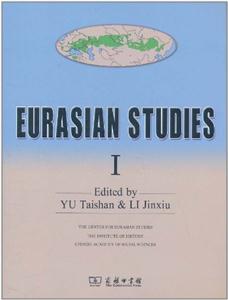-
>
西班牙语词根宝典
-
>
英语大书虫世界经典名译典藏书系:中国人的精神 (英汉对照)(精选权威版本)
-
>
许渊冲译唐诗三百首:汉文·英语
-
>
四级词汇词根+联想记忆法:乱序版
-
>
The secret garden
-
>
英国文学名篇选注
-
>
许渊冲译千家诗
EURASIAN STUDIES-Ⅰ 版权信息
- ISBN:9787100075367
- 条形码:9787100075367 ; 978-7-100-07536-7
- 装帧:简裝本
- 册数:暂无
- 重量:暂无
- 所属分类:>>
EURASIAN STUDIES-Ⅰ 内容简介
《欧亚学刊(英文版)》主要内容包括:Salutations from the Foundation for East-West Understanding and Cooperation to Eurasian Studies (CFES, CASS)、The Editors、Editorial Foreword、A Study on the Kidarites:Based Primarily on Documentary Sources、History of the Yeda Tribe (Hephthalites):Further Issues、Further Remarks on the Migrations and Settlements of the Sogdians in the Northern Dynasties, Sui and Tang、Chengbang and the Tang Empire、Tribes of the Mohe and the Founding Group of the Bohai State等。
EURASIAN STUDIES-Ⅰ 目录
Salutations from the Foundation for East-West Understanding and Cooperation to Eurasian Studies (CFES, CASS)
The Editors
Editorial Foreword
Wan Xiang
A Study on the Kidarites:Based Primarily on Documentary Sources
Yu Taishan
History of the Yeda Tribe (Hephthalites):Further Issues
Rong Xinjiang
Further Remarks on the Migrations and Settlements of the Sogdians in the Northern Dynasties, Sui and Tang
Li Jinxiu
Chengbang and the Tang Empire
Yang Jun
Tribes of the Mohe and the Founding Group of the Bohai State
Chen Gaohua
Several Issues about Turpan in the Ming Dynasty
Khoshut Tsengel (Qinggeli)
The Formation of the D6rben Oyirad Alliance
Shen Weirong
Chinese Tantric Buddhist Literature under the Tangut Kingdom and Yuan Dynasty:Chinese translations of Tibetan
Ritual Texts unearthed in Khara Khoto
Zhou Weizhou
On the Relationship and Border Demarcation Problems between Tibet and Ladakh in the 19th Century
Lin Wushu and Wang Yuanyuan
Persian Zoroastrianism and the Worship of the God of Xian in Ancient China
Rui Chuanming
A Study on the Relations between Maitreyan Faith and Manichaeism
Ma Xiaohe
The Manichaean "Twelve Dominions" and "Three Days of Light".
EURASIAN STUDIES-Ⅰ 节选
In the 17th year (1504) of Hongzhi, Ahmed died and his eldest son Mansur succeeded him. Mansur had four brothers (some said three): his younger brother Babacha 把巴叉 (or Babadai 把巴歹), who had the same mother as Mansur, and younger brothers Ren Timur 忍帖木儿, Zhen Timur 真帖木儿and an unknown one, who had different mothers. ZhenTimur was detained by the Ming Dynasty in Ganzhou for a time and later sent back. Babacha controlled Aksu 阿克苏 (today's Aksu/Aqsu, Xinjiang). After the Ming recovered Hami fora second time, Shanba was made king of Hami. When he died, his son Baiya 拜牙 succeeded to the throne. In the 8th year (1513) of the Zhengde 正德 reign, Baiya fied to Turpan, and from there he was sent to "the land of Sultan Mansur's younger brother Babacha in Aksu". Babacha and Mansur "did not get on harmoniously as brothers". When the Ming court "iSsued an imperial edict" requesting Babacha to send Baiya "back to his home state", "the head of Turpan's tribute mission and Hami's governing head" traveled together to Aksu to present the order and rewards. Obviously, Mansur was trying to prevent Babacha from establishing direct contact with the Ming Dynasty. According to the historical account, relations between Babacha and Mansur were strained because Babacha "blamed his elder brother [Mansur] for committing the wrong of cutting off the golden road", in other words, by initiating war swhich resulted in the Ming Dynasty closing its doors and stopping trade between the Central Plains and Xinjiang, the "golden road" 金路 referring to the trade routes. The city ofAksuwas under Babacha's control. In the meantime, Mansur "deployed the Chalishi 察力失(叉力失) army to the land of the Hans", in preparation for looting raids. Chalishi was also affili-ated to Turpan, as described by Yan Song 严嵩, writing in the 16th year (1537) of the Jiajing嘉靖 reign: "It was six or seven hundred li from Turpan to Chalishi, which was called Yanze 盬泽 in the Han Dynasty and belongs to Turpan now." It could be concluded from the account that the Ming court saw Chalishi as part of the Turpan state. Gui E said that Babacha“lives in the walled town of Chalishi, about four or five hundred li west of that of Turpan, and has about 1,000 or 2,000 soldiers". This record conflicts with other accounts in which Babacha was domiciled in Aksu. It is possible that Babacha lived in Chalishi before going to Aksu, but the statement could also have been erroneous. However, it seems certain that Chalishi and Aksu both belonged to the Turpan polity during the reign of Mansur, and it can be concluded that Turpan was very influential in the first half of the 16th century.
In the 24th year (1545) of Jiajing, "Mansur died, and his eldest son Sha 沙 succeeded to the throne and became Sultan. His younger brother Muhammad 马黑麻 also called himself Sultan and took Hamj". At the end of the 44th year (1564/1565) or the beginning ofthe 46th year (1566) of Jiajing, "Sultan Sha, in a secret act, looted the northern tribe [Oyirad], and died after he was shot by an arrow.
……
- >
罗庸西南联大授课录
罗庸西南联大授课录
¥13.8¥32.0 - >
伊索寓言-世界文学名著典藏-全译本
伊索寓言-世界文学名著典藏-全译本
¥9.3¥19.0 - >
月亮与六便士
月亮与六便士
¥18.1¥42.0 - >
上帝之肋:男人的真实旅程
上帝之肋:男人的真实旅程
¥30.5¥35.0 - >
朝闻道
朝闻道
¥15.0¥23.8 - >
企鹅口袋书系列·伟大的思想20:论自然选择(英汉双语)
企鹅口袋书系列·伟大的思想20:论自然选择(英汉双语)
¥9.7¥14.0 - >
自卑与超越
自卑与超越
¥13.5¥39.8 - >
中国历史的瞬间
中国历史的瞬间
¥16.7¥38.0
-
THE GREAT GATSBY-了不起的盖茨比
¥8.4¥16.8 -
地心游记(纯英文)/床头灯英语.3000词读物
¥9¥15.8 -
呼啸山庄-英语原著版
¥10.7¥18 -
教师-中译经典文库-世界文学名著-第五辑
¥9¥14 -
小妇人(纯英文)/床头灯英语.3000词读物
¥9¥15.8 -
方法论
¥6.3¥9.5




















